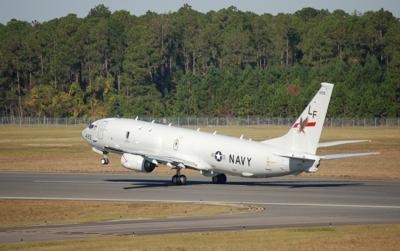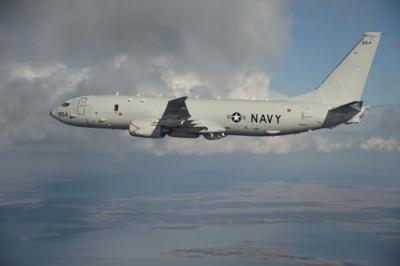First Two Aircraft Departed For Deployment Nov 29
The Navy's newest maritime patrol and reconnaissance aircraft, the P-8A Poseidon, has achieved initial operational capability (IOC) after the first two P-8A Poseidons departed for deployment Nov. 29. This announcement comes weeks after the completion of the Operational Readiness Evaluation of the first deploying P-8A Poseidon squadron and the commander of Patrol and Reconnaissance Group officially declaring the first P-8A squadron, Patrol Squadron 16 (VP-16), "prepared for deployment" Nov. 4.

"This IOC declaration is the culmination of years of careful planning and coordinated effort by the fleet, resource sponsor, acquisition community, and industry," said Capt. Scott Dillon, program manager for Maritime Patrol and Reconnaissance Aircraft Program Office (PMA-290).
By achieving IOC, the Navy can effectively deploy the P-8A for operational missions and continue to successfully transition from the aging P-3C. The Poseidon program is on track for completing the remaining preparations for the first operational deployment of a P-8A squadron.
"With the P-3 to P-8 transition well underway at Jacksonville (FL), VP-16 is executing an Inter-Deployment Readiness Cycle and is on track to be the first P-8 squadron to deploy. VP-5 has completed their P-8 transition, and VP-45 has commenced P-8 transition after returning from deployment this past summer. In addition to leading the fleet transition process, VP-30 is also producing P-8 qualified replacement personnel for direct accession into P-8 qualified squadrons," said Rear Adm. Matt Carter, Commander Patrol and Reconnaissance Group. "There has never been a greater need for a new patrol and reconnaissance aircraft now that the aging P-3 is nearing the end of its life cycle. The P-8 is a true multi-mission platform, which will continue to provide us invaluable capabilities."
"The number of submarines in the world is increasing rapidly. Other countries are either building or purchasing advanced, quiet, and extremely hard to find submarines and we need to be able to match that technology to be able to detect them. The P-8, along with the Triton, will strengthen the maritime mission and provide greater situational awareness," Carter added.

This year was filled with crucial programmatic milestones for the program office, including the successful completion of Initial Operational Test and Evaluation and the on-going delivery of initial production aircraft in support of the first three P-3 to P-8 squadron transitions. To date, 12 low rate initial production aircraft were delivered to the fleet, and the final aircraft in the second production lot is on-track to deliver ahead of schedule and prior to the end of the year.
The program office along with the P-8 Fleet Integration Team in Naval Air Station (NAS) Jacksonville, FL, is continuing to support the transitioning squadrons with training by also using the P-8A Integrated Training Center (ITC). The ITC is meeting training requirements of the Fleet Replacement Squadron, VP-30, and the transitioning squadrons.
"We are pleased the P-8A has been, and continues to be, on cost and on schedule," Dillon said. "The program office is continuing to support the needs of the fleet and deliver an aircraft that recapitalizes and improves upon the capabilities of its predecessor; greatly enhancing the effectiveness of the Navy's forward deployed squadrons."
(Images provided by the U.S. Navy)
 ANN's Daily Aero-Term (10.31.25): Minimum Sector Altitude [ICAO]
ANN's Daily Aero-Term (10.31.25): Minimum Sector Altitude [ICAO] ANN's Daily Aero-Linx (10.31.25)
ANN's Daily Aero-Linx (10.31.25) NTSB Final Report: Airbus A321-271N (A1); Cessna 172N (A2)
NTSB Final Report: Airbus A321-271N (A1); Cessna 172N (A2) ANN FAQ: Follow Us On Instagram!
ANN FAQ: Follow Us On Instagram! Airborne 10.30.25: Earhart Search, SpaceX Speed Limit, Welcome Back, Xyla!
Airborne 10.30.25: Earhart Search, SpaceX Speed Limit, Welcome Back, Xyla!




